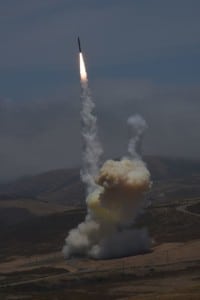The White House recently announced it “strongly opposes” several provisions related to the Ballistic Missile Defense System (BMDS) and hypersonic missile defense in the Senate’s fiscal year 2023 defense authorization bill.
On Oct. 19, the Office of Management and Budget (OMB) published a Statement of Administration Policy that argued it “strongly opposes sections…which propose significant modifications to plans for the BMDS, which is inconsistent with both existing organizational roles and the [National Defense Strategy].
One section would require the director of the Missile Defense Agency (MDA) to develop a plan to conduct persistent cybersecurity operations across all networks and information systems supporting the Ballistic Missile Defense System. MDA would coordinate with combatant commands and the Director for Operational Test and Evaluation (DOT&E), the department’s chief weapons tester.

However, the White House said this “is a significant departure from the mission of MDA. MDA serves in a supporting role once capability has been delivered to the warfighter and has no expertise or authority to conduct cybersecurity operations on operational systems.”
OMB also argued against a provision that requires a funding plan to acquire at least 64 Next Generation Interceptors (NGIs) for the Ground-based Midcourse Defense system, up from the MDA’s plan for 20 new interceptors (Defense Daily, July 25).
The NGI, which aims to provide improved defenses of the U.S. from a limited number of nuclear-armed intercontinental ballistic missiles, includes a new booster rocket and kill vehicle to replace the canceled Redesigned Kill Vehicle. The 20 NGIs are expected to be installed in 20 silos already built at the missle defense site at Fort Greely, Alaska.
“By more than tripling the planned inventory of Next Generation Interceptors, section 1544 would be extremely costly and inconsistent with both the 2022 NDS and 2022 Missile Defense Review. The Department is exploring more cost-effective approaches to address the nuclear threat from North Korea,” the administration said.
MDA previously said the cost of 20 NGIs alone would be upward of $11 billion.
MDA currently fields 44 older Ground-Based Interceptors (GBIs) at Fort Greely and Vandenberg Space Force Base, Calif.
In 2021, MDA chose teams led by Northrop Grumman [NOC] and Lockheed Martin [LMT] to work on initial technology development and risk reduction for the NGI, with competition expected to last through critical design review (Defense Daily, March 23, 2021).

During a May Senate Armed Services Committee hearing, MDA director Vice Adm. Jon Hill said the Pentagon expects to decide precisely how many NGIs to buy around 2024, after the preliminary reviews are complete (Defense Daily, May 23).
Separately, OMB said the administration opposes additional funding for the Glide-Phase Interceptor (GPI) hypersonic defense program and homeland cruise missile defense demonstration because they “do not align with the Department’s planned efforts.”
DoD requested about $225 million for GPI, but the Senate bill authorizes another $292.5 million, for a total of about $518 million.
The administration opposed this because “the technological maturity of GPI is currently too low to support such an acceleration, and the Department is investing heavily in other near-term counter-hypersonic capabilities, such as the SM-6 and non-traditional approaches.”

In February, Hill said the Standard Missile-6 has a “nascent ability” to hit hypersonic missile targets due to its high-speed maneuver capabilities (Defense Daily, Feb. 3). Last year, Rear Adm. Tom Druggan, then-Program Executive for Aegis Ballistic Missile Defense (BMD), also called the SM-6 “our leading defensive capability for hypersonic missile defense,” with respect to potential Guam defense systems (Defense Daily, Nov. 24, 2021).
MDA awarded Raytheon Technologies [RTX], Lockheed Martin [LMT] and Northrop Grumman [NOC] $19 million to $21 million a year ago to work on accelerated concept designs for the GPI (Defense Daily, Nov. 22, 2021).
In June, MDA down-selected to Raytheon and Northrop Grumman with $31 million modifications to continue refining and developing the concept work through February 2023 (Defense Daily, June 24).
In September Raytheon said it completed the Systems Requirements Review-Prototype for GPI and was moving to preliminary design (Defense Daily, Sept. 22).
MDA originally split the hypersonic defense plans in early 2021 from the previous Regional Glide Phase Weapon System into the nearer-term GPI and a separate longer-term capability (Defense Daily, Feb. 4, 2021).